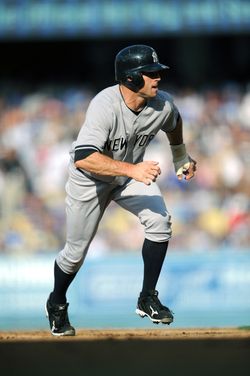Since the Philadelphia Phillies traded four prospects for Hunter Pence last month, things couldn't be going better – Pence is at .344/.408/.557 in his first 16 games. Still, the price was awfully steep for two years and two months of Pence, a 28-year-old corner outfielder with a career OPS+ of 118.
The four players Houston received – Jarred Cosart, Jonathan Singleton, Domingo Santana and Josh Zeid – represented three of the top nine Phillies prospects heading into the season, according to Baseball America, with Zeid checking in at 23rd. If the Phillies win another World Series or two, all that is likely to be forgotten. But when compared to Rondell White, a strikingly similar player in terms of value at the time he was traded, it is hard to feel as if the Phillies got a proper return.
When the Montreal Expos traded Rondell White in July 2000, he was 28 years old, just like Pence is now. His career OPS+ at the time was 113, lower than Pence's 118, though his offensive WAR was virtually identical: 12.4 in roughly 3,000 plate appearances, to Pence's 12.6 in roughly 3,000 plate appearances. Add defense into the equation, though, and White's overall WAR jumps to 17.7; Pence's falls to 11.0.
With both White and Pence a year and two months from free agency, it becomes clear that White was at least as valuable an asset at the time of the deal. So if the Astros got four prospects, including three elite ones, what did Montreal get from the Chicago Cubs for Rondell White?
Scott Downs. Just Scott Downs. Already 24 years old, having been traded from the Cubs to the Twins and then back, Downs was deemed the proper compensation for the Hunter Pence of his time, Rondell White. This is no knock on Downs, who has since enjoyed a strong career and become one of the best, most consistent left-handed relievers in the game.
But the Astros didn't deal for Cosart, Singleton or even Santana hoping for the value of a middle reliever. That's what they are probably hoping for from Zeid, the fourth-best player in the deal. Downs didn't help matters by pitching just three innings for the Expos, then having Tommy John surgery knock him out until 2002.
The deal worked out somewhat well for the Cubs, though White didn't become the stretch-run contributor the Cubs wanted. He played in 19 games, all starts, before injury ended his season on August 26. At that time, the Cubs were at the outer edges of the 2000 pennant chase, 8.5 games behind the Cardinals in the NL Central and 10 games behind the Mets for the Wild Card. But by the time White gave way to a September of Ross Gload and Roosevelt Brown in left field, the Cubs were all but eliminated.
White contributed greatly to a 2001 Cubs team that finished 88-74, a respectable third place in the NL Central. His OPS+ of 134 was second among all Cub regulars to Sammy Sosa's 203, and his WAR of 2.0 placed him in a tie for third on the team with Bill Mueller. Still, White's injury problems limited him to just 95 games and after the season, the Cubs saw him sign as a free agent with the New York Yankees.
Obviously, the major advantage Pence has over White is durability, with at least 156 games played in each of his full seasons. The extent to which White's defensive value evens that out is noteworthy, however. Had the Phillies merely dealt a 24-year-old Scott Downs – say, Kyle Kendrick – for a player of Pence/White's caliber, the trade would have been an outright heist. Seeing four prospects go in such a deal could be remembered very differently, however.

